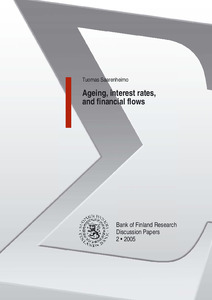Ageing, interest rates, and financial flows
Saarenheimo, Tuomas (05.01.2005)
Numero
2/2005Julkaisija
Suomen Pankki
2005
Julkaisun pysyvä osoite on
https://urn.fi/URN:NBN:fi:bof-20140807114Tiivistelmä
The median age of the global population is presently increasing by nearly three months every year.Over the next couple of decades, almost every country in the world is set to experience an unprecedented increase in the share of elderly population.This development has the potential to fundamentally affect the functioning of economic and financial systems globally.This study concentrates on the effects of ageing on the evolution of global interest rates and financial flows.The study uses a 73-cohort general equilibrium overlapping generations model of five major economic areas (USA, EU-15, Japan, China, and India).Utilising actual population data and UN population projections, the model yields predictions for major economic and financial variables up to 2050.The model predicts a decline in global equilibrium real interest rates over the next two decades, but the size of the decline depends crucially on the future evolution of public pension benefits.If the present generosity of pension systems is maintained - leading to a steep increase in the cost of the pension systems - the maximum decline of interest rates is projected to be about 70 basis points from present levels.If pension benefits are reduced to offset the increasing cost pressures, the decline in global equilibrium interest rates can be much larger, while increases in the retirement age work in the opposite direction.The results do not anticipate a 'financial market meltdown' - a collapse in asset prices associated with the retirement of the baby-boomers - predicted by some.On the contrary, bond prices should fare fairly well over the next three decades.The main reason for this is that increasing life expectancy at retirement creates a need for higher retirement saving - in the future, people will want to retire wealthier than they do today.This trend more than offsets the negative effect of the retirement of baby-boomers on asset demand.Key words: Ageing, real interest rates, financial flows, public pension systems JEL classification numbers: J11, E44
